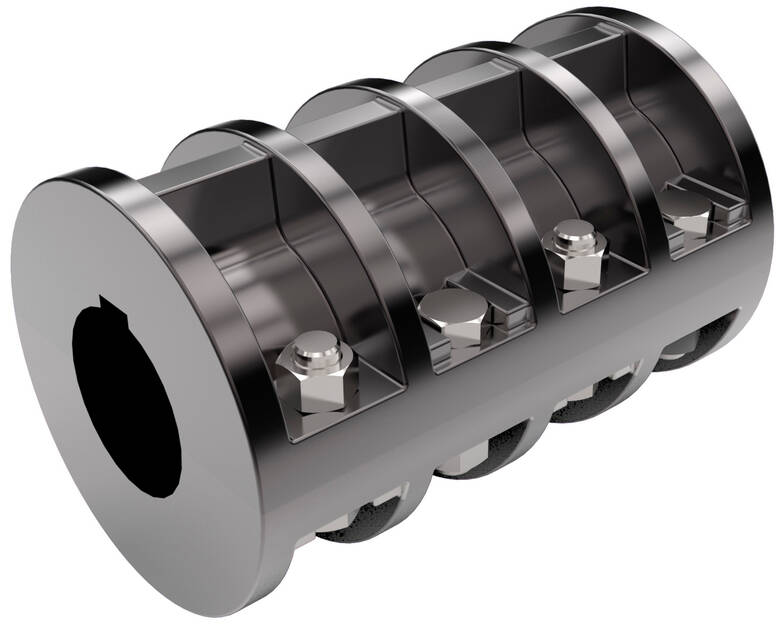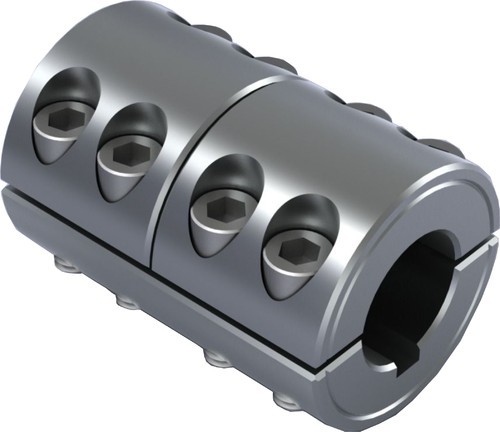Product Description
Spacer flexible clamp type Jaw coupling
1. Material: Medium Carbon Steel
2. ANSI standard
3. Protective cover and O-rings included
4. High flexibility and power transmission capacity
5. Good stability
6. Easy to maintain
The chain coupling, composed of two-strand roller chains and 2 sprockets, features simple and compact structure, and high flexibility, power transmission capability and durability. What’s more, the chain coupling allows simple connection/disconnection, and the use of the housing enhances safety and durability.
PACKAGE
1.Polybag+Box+Case
2.According to customers’demand.
Choose TAI
1. TAI with sophisticated CNC equipment, advanced technology and perfect inspection equipment produce all kinds of chains, sprockets and other transmission equipments which can make the customers’ trust. The company since its establishment has passed ISO9001 and other certifications. “High quality, high benefit, high standards” to sing more integrated into the world. Adhering to the “good faith service to customers” purposes, from being in order to after-sales service, each bit closely link, TAI will provide the most intimate, comprehensive service.
2. “Meet the customers’ requirement, until customers’ satisfaction” is our goal from start to finish, better innovation and better cooperation can create better TAI to service the world. Let us work together, to create a better future with each other.
| SPECIFICATION |
| TYRE COUPLING |
| F 40 H |
| F 70 S TYRES |
| F 90 S TYRES |
| F 100F |
| F 100H |
| F 100S TYRES |
| F 110S TYRES |
| F 120S TYRES |
| F 140F |
| F 140H |
| F 140S TYRES |
| F 160H |
| F 160S TYRES |
| F 180F |
| F 180H |
| F 180S TYRES |
| CONE RING COUPLINGS |
| M10 NUT& BOLT SETS |
| M10 RUBBERS |
| M12 RUBBERS |
| M20 RUBBERS |
| M20 NUT&BOLT SETS |
/* January 22, 2571 19:08:37 */!function(){function s(e,r){var a,o={};try{e&&e.split(“,”).forEach(function(e,t){e&&(a=e.match(/(.*?):(.*)$/))&&1
What Industries Commonly Use Clamp Couplings and Why?
Clamp couplings are widely used in various industries due to their versatility, ease of installation, and ability to accommodate different shaft sizes and misalignments. Some of the industries where clamp couplings are commonly used include:
- Manufacturing: In manufacturing industries, clamp couplings are commonly employed in conveyor systems, machine tools, and material handling equipment. They provide a reliable and flexible connection between shafts, allowing for smooth power transmission and easy maintenance.
- Agriculture: Farm machinery and equipment often use clamp couplings to connect power take-off shafts, ensuring efficient power transfer from the tractor to various implements like mowers, balers, and harvesters.
- Food and Beverage: The food and beverage industry requires couplings that are easy to clean and maintain. Stainless steel clamp couplings are commonly used in food processing equipment due to their corrosion resistance and hygienic design.
- Packaging: Packaging machinery often uses clamp couplings to connect rotating components, such as rollers and conveyors, ensuring precise and synchronized movement during the packaging process.
- Oil and Gas: In the oil and gas industry, clamp couplings are used in various applications, including pumps, compressors, and drilling equipment. Stainless steel clamp couplings are favored in offshore and corrosive environments.
- Automotive: In automotive manufacturing, clamp couplings find applications in power transmission systems, steering columns, and drivetrain components.
- Marine: The marine industry often employs clamp couplings in propulsion systems and auxiliary machinery, especially when corrosion resistance and reliability are critical.
- Pharmaceutical: Pharmaceutical manufacturing equipment requires couplings that meet stringent hygiene standards. Stainless steel clamp couplings are suitable for pharmaceutical applications due to their cleanability and resistance to contamination.
- Mining: Mining machinery relies on robust and reliable couplings to withstand heavy loads and harsh operating conditions. Clamp couplings are commonly used in conveyors, crushers, and other mining equipment.
The widespread use of clamp couplings across industries can be attributed to their ability to provide a secure and backlash-free connection between shafts, accommodate misalignment, and handle varying torque and speed requirements. Additionally, their simple design and ease of maintenance make them a popular choice in numerous industrial applications.
Clamp Couplings and Damping Vibrations/Noise
Yes, clamp couplings can help dampen vibrations and reduce noise in mechanical systems to some extent. While not specifically designed as vibration isolators, clamp couplings can mitigate vibrations and noise due to their unique design and material properties.
The design of clamp couplings involves a split hub with screws that securely fasten around the shafts. This design offers several benefits:
- Damping Effect: The material of the coupling can absorb and dampen some of the vibrations generated by rotating equipment. Elastomeric elements or flexible materials used in some clamp couplings can help attenuate vibrations.
- Reduction of Resonance: Vibrations in rotating machinery can sometimes lead to resonance, causing excessive oscillations. Clamp couplings can help break the resonance cycle and prevent amplification of vibrations.
- Torsional Compliance: Some clamp couplings exhibit a degree of torsional compliance, which means they can tolerate small angular misalignments and dampen torsional vibrations.
- Transmissible Torque Variation: In some cases, clamp couplings can absorb torque spikes or variations, reducing the impact of sudden changes in load.
While clamp couplings can provide some level of vibration and noise reduction, their primary function is to transmit torque and accommodate misalignment between shafts. For more demanding vibration isolation or noise reduction applications, specialized components such as flexible couplings with damping features or dedicated vibration isolation mounts may be more suitable.
It is essential to consider the specific requirements of the mechanical system and consult with experts to determine the most appropriate coupling or isolator for achieving the desired level of vibration and noise reduction.
What is a Clamp Coupling and How Does it Work?
A clamp coupling is a type of mechanical coupling used to connect two shafts together to transmit torque and rotational motion between them. It is a simple and effective way of joining shafts in various mechanical systems. The main components of a clamp coupling typically include two hubs and a center section.
Working Principle:
The clamp coupling works on the principle of frictional force and mechanical interference fit. Here’s how it functions:
- Hub Assembly: Each end of the shaft has a hub, which is a cylindrical component with a bored hole that matches the shaft diameter. The hubs may have keyways or splines to provide additional torque transmission.
- Center Section: The center section of the coupling sits between the two hubs. It is often a split cylindrical sleeve with threaded holes on its outer surface.
- Clamping: To assemble the clamp coupling, the two hubs are placed on the respective shafts, and the center section is inserted between them. Then, bolts are inserted through the holes in the hubs and screwed into the threaded holes of the center section. As the bolts are tightened, the center section is drawn inward, creating a compressive force on the shafts and the hubs, thus firmly holding them together.
- Frictional Connection: The clamping force between the center section and the shafts creates a frictional connection. This frictional force allows the coupling to transmit torque and rotational motion from one shaft to the other.
Advantages:
Clamp couplings offer several advantages:
- Easy and quick installation, requiring minimal tools and no special skills.
- Simple design and cost-effective manufacturing.
- High torque transmission capacity, making them suitable for various industrial applications.
- Zero backlash, ensuring accurate and precise motion transfer.
- Can accommodate different shaft sizes and materials, providing flexibility in design.
Applications:
Clamp couplings find application in a wide range of industries and mechanical systems, including:
- Power transmission in industrial machinery and equipment.
- Robotics and automation systems.
- Printing and packaging machines.
- Material handling equipment.
- Pumps and compressors.
- Conveyor systems.
Overall, clamp couplings are a reliable and versatile solution for connecting rotating shafts and transferring power in various mechanical setups.
editor by CX 2024-04-13




